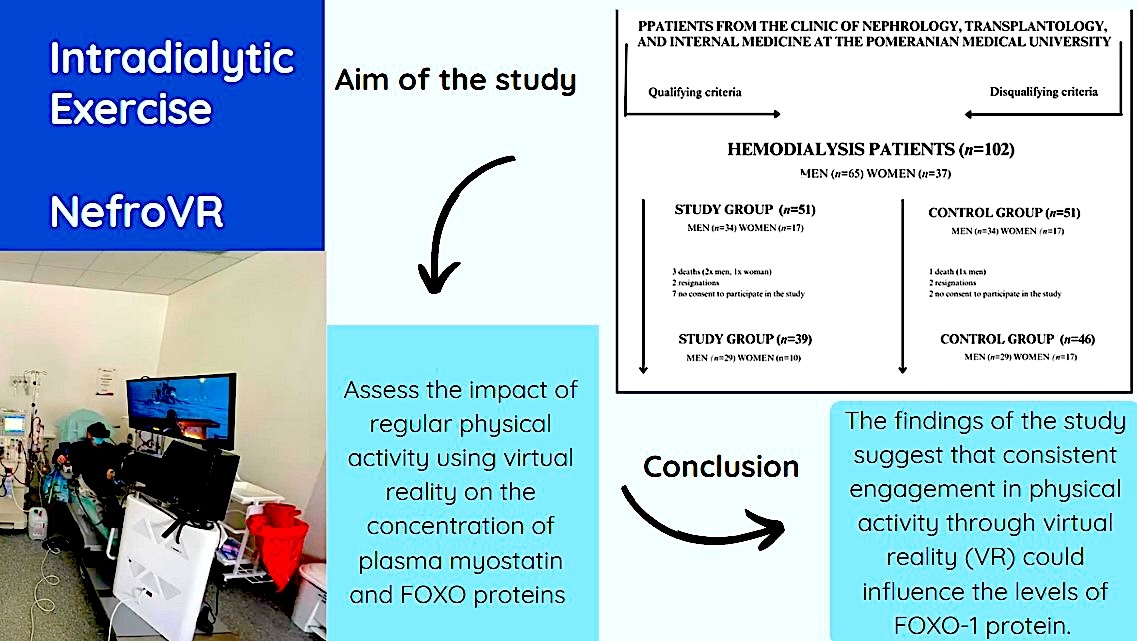Current issue
Archive
Manuscripts accepted
About the Journal
Editorial office
Editorial board
Section Editors
Abstracting and indexing
Subscription
Contact
Ethical standards and procedures
Most read articles
Instructions for authors
Article Processing Charge (APC)
Regulations of paying article processing charge (APC)
NEPHROLOGY / RESEARCH PAPER
Does Regular Physical Activity During Hemodialysis Affect the Levels of FoxO Proteins and Myostatin Concentration?
1
Department of Medical Rehabilitation and Clinical Physiotherapy, Pomeranian Medical University, Poland
2
Department of Microbiology, Immunology and Laboratory Medicine, Pomeranian Medical University, Poland
3
Department of Reconstructive Surgery and Gynecological Oncology, Pomeranian Medical University, Poland
4
Department of Nephrology, Transplantology and Internal Medicine, Pomeranian Medical University, Poland
Submission date: 2025-01-22
Final revision date: 2025-03-29
Acceptance date: 2025-04-06
Online publication date: 2025-05-18
Corresponding author
Alicja Mińko
Department of Medical Rehabilitation and Clinical Physiotherapy, Pomeranian Medical University, Żołnierska 54, 71-210, Szczecin, Poland
Department of Medical Rehabilitation and Clinical Physiotherapy, Pomeranian Medical University, Żołnierska 54, 71-210, Szczecin, Poland
KEYWORDS
TOPICS
ABSTRACT
Introduction:
The implementation of virtual reality (VR) technology in the context of hemodialysis represents a groundbreaking approach that has the potential to greatly enhance patients' motivation to engage in physical exercise. Physical exercise during hemodialysis has a positive impact on chronic inflammation, well-being, muscle mass and strength, and the risk of cardiovascular diseases. The aim of this study was to comprehensively evaluate the impact of regular physical activity using virtual reality during hemodialysis sessions on plasma concentrations of myostatin and FOXO proteins, with particular emphasis on enhancing training attractiveness and patient motivation.
Material and methods:
The study was conducted at the Department of Nephrology, Transplantology, and Internal Diseases in Szczecin (Polnad). The study group was tasked with engaging in training sessions utilizing the NefroVR system prototype. In contrast, patients in the control group did not participate in any intervention. To assess the concentration of FOXO1, FOXO2, FOXO3 and myostatin parameters, blood was collected from the subjects twice: on the day of the study and after 3 months of its duration.
Results:
A total of 102 patients were selected for participation in the study. The study group showed lower FOXO-1 values compared to the control group at measurement 2 (p = 0.041). In the study group, a statistically significant correlation was observed between measurements 1 and 2 in the FOXO1 measurement (p = 0.045).
Conclusions:
The findings of the study suggest that that training performed 3 times a week for 3 months through virtual reality (VR) could reduce FOXO-1 protein levels.
The implementation of virtual reality (VR) technology in the context of hemodialysis represents a groundbreaking approach that has the potential to greatly enhance patients' motivation to engage in physical exercise. Physical exercise during hemodialysis has a positive impact on chronic inflammation, well-being, muscle mass and strength, and the risk of cardiovascular diseases. The aim of this study was to comprehensively evaluate the impact of regular physical activity using virtual reality during hemodialysis sessions on plasma concentrations of myostatin and FOXO proteins, with particular emphasis on enhancing training attractiveness and patient motivation.
Material and methods:
The study was conducted at the Department of Nephrology, Transplantology, and Internal Diseases in Szczecin (Polnad). The study group was tasked with engaging in training sessions utilizing the NefroVR system prototype. In contrast, patients in the control group did not participate in any intervention. To assess the concentration of FOXO1, FOXO2, FOXO3 and myostatin parameters, blood was collected from the subjects twice: on the day of the study and after 3 months of its duration.
Results:
A total of 102 patients were selected for participation in the study. The study group showed lower FOXO-1 values compared to the control group at measurement 2 (p = 0.041). In the study group, a statistically significant correlation was observed between measurements 1 and 2 in the FOXO1 measurement (p = 0.045).
Conclusions:
The findings of the study suggest that that training performed 3 times a week for 3 months through virtual reality (VR) could reduce FOXO-1 protein levels.
Share
RELATED ARTICLE
We process personal data collected when visiting the website. The function of obtaining information about users and their behavior is carried out by voluntarily entered information in forms and saving cookies in end devices. Data, including cookies, are used to provide services, improve the user experience and to analyze the traffic in accordance with the Privacy policy. Data are also collected and processed by Google Analytics tool (more).
You can change cookies settings in your browser. Restricted use of cookies in the browser configuration may affect some functionalities of the website.
You can change cookies settings in your browser. Restricted use of cookies in the browser configuration may affect some functionalities of the website.



